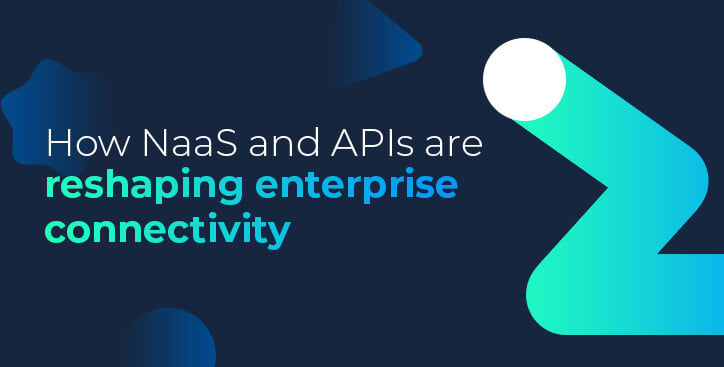How NaaS and APIs are reshaping enterprise connectivity
By Lily Bennett|16 October, 2024

As enterprises continue to migrate workloads to cloud environments, they are reaping significant benefits, such as scalability, agility, and the ability to deploy applications in near real-time. However, these advantages are often undermined by the limitations of legacy networks. Traditional networks, restricted by long-term contracts and inflexible delivery timelines, are no longer fit for purpose in a cloud-driven world. Businesses now demand network services that are as dynamic as the cloud environments they have adopted, and this is where Network-as-a-Service (NaaS) and APIs can offer transformative solutions to bridge the gap.
MEF, a non-profit industry forum made up of network, cloud and technology providers, has jointly written a white paper with service providers on NaaS Customer Experience, to outline what enterprises should be expecting from their NaaS offering. In this blog, we explore the challenges enterprises face when managing their networks and cloud adoption, and how NaaS is positioned to support this.
The legacy network and cloud divide
The disparity between cloud consumption models and legacy networks is evident in the speed of deployment and contract flexibility. For example, while cloud compute resources can be provisioned within minutes for short-term projects, traditional network services often come with year-long contracts and require weeks to activate. This rigidity no longer meets the requirements of enterprises who now require the agility offered by cloud services.
NaaS providers aim to address this challenge by offering a cloud-like consumption model for network services. NaaS allows businesses to provision, scale, and adapt their networks in real-time, offering a level of flexibility that matches the dynamic nature of cloud computing. Whether it’s scaling bandwidth during periods of high demand or rerouting circuits in response to an outage, NaaS gives enterprises the agility they need to respond to changing market conditions. Flexible commercial models, such as short-term, pay-as-you-go agreements, allow businesses to tailor their network usage to their needs, avoiding the pitfalls of fixed, static billing models.
Additionally, as enterprises advance in their digital transformation journey, they are looking for more control over their network services. Traditional network provisioning, which often involves human interaction and sales negotiations, is being replaced by self-service capabilities. Through web portals or APIs, enterprises can now quote, order, and provision network services in real-time, enabling greater autonomy and faster response times.
The essential features of NaaS
In the white paper, MEF defines NaaS as the combination of on-demand connectivity, application assurance, cybersecurity, and multi-cloud-based services across a standards-based automated ecosystem. As outlined by MEF, five of the key features of a NaaS offering include:
- Standardised API access: A standardised API is essential for accessing NaaS functionality. Defined by MEF standards, these APIs allow customers to manage their networks programmatically, integrating network orchestration into their workflows.
- Real-time firm pricing: Enterprises require firm pricing for network services in real-time, ensuring they know the exact cost and terms before committing. This transparency helps businesses make informed decisions when provisioning services.
- Bundle ordering: NaaS platforms enable enterprises to order bundled services, for example, bundling core underlay connectivity with SD-WAN overlay and customer web services, ensuring optimised performance at competitive prices.
- Short or zero-commitment contracts: Flexibility is a hallmark of NaaS. Enterprises can contract services on a short-term basis, ranging from hours to days, allowing for greater adaptability without long-term financial commitments.
- Pay-as-you-use billing: NaaS offers consumption-based billing, where charges are based on usage or time. This provides enterprises with a real-time view of their charges, giving them full transparency and control over their expenses.
Key benefits of Console Connect
Considering the essential features of NaaS and by complying with MEF standards, Console Connect can offer enterprises these benefits:
- Enhanced performance: Console Connect offers high throughput, low latency, and optimal routing for improved network performance.
- Optimised cloud access: Seamlessly connect multiple cloud platforms, regions, and on-premises data centres to enhance your multi-cloud strategy.
- Increased network reliability: Console Connect avoids public internet bottlenecks, ensuring SLA-backed performance for mission-critical applications.
- Automation and agility: The use of SDN and APIs enables network automation and agility, allowing businesses to adapt quickly to changing needs.
- Flexibility and control: With real-time bandwidth adjustments and self-service portals, enterprises have full control over their network provisioning and management.
- Reduced complexity: Console Connect simplifies end-to-end network management with real-time connectivity monitoring, reducing the risk of downtime and service disruptions.
Are you looking to streamline your API integration? Learn more about how our advanced API mapping solution could help you manage your API integrations and cloud connectivity.

.jpg)





.jpg)
